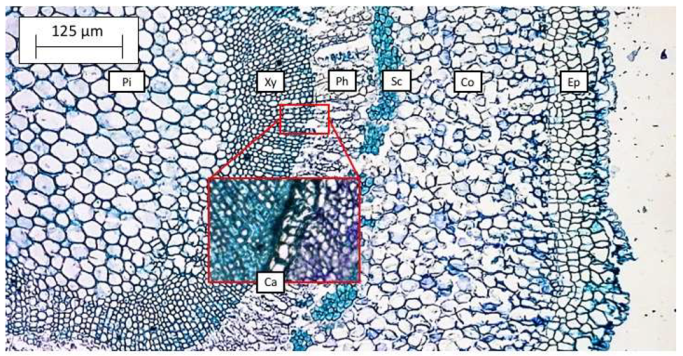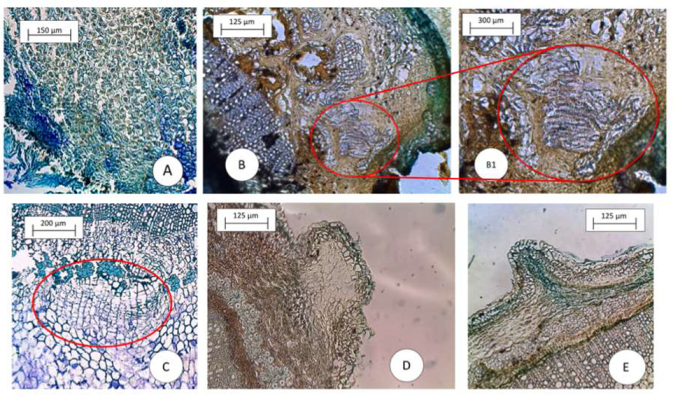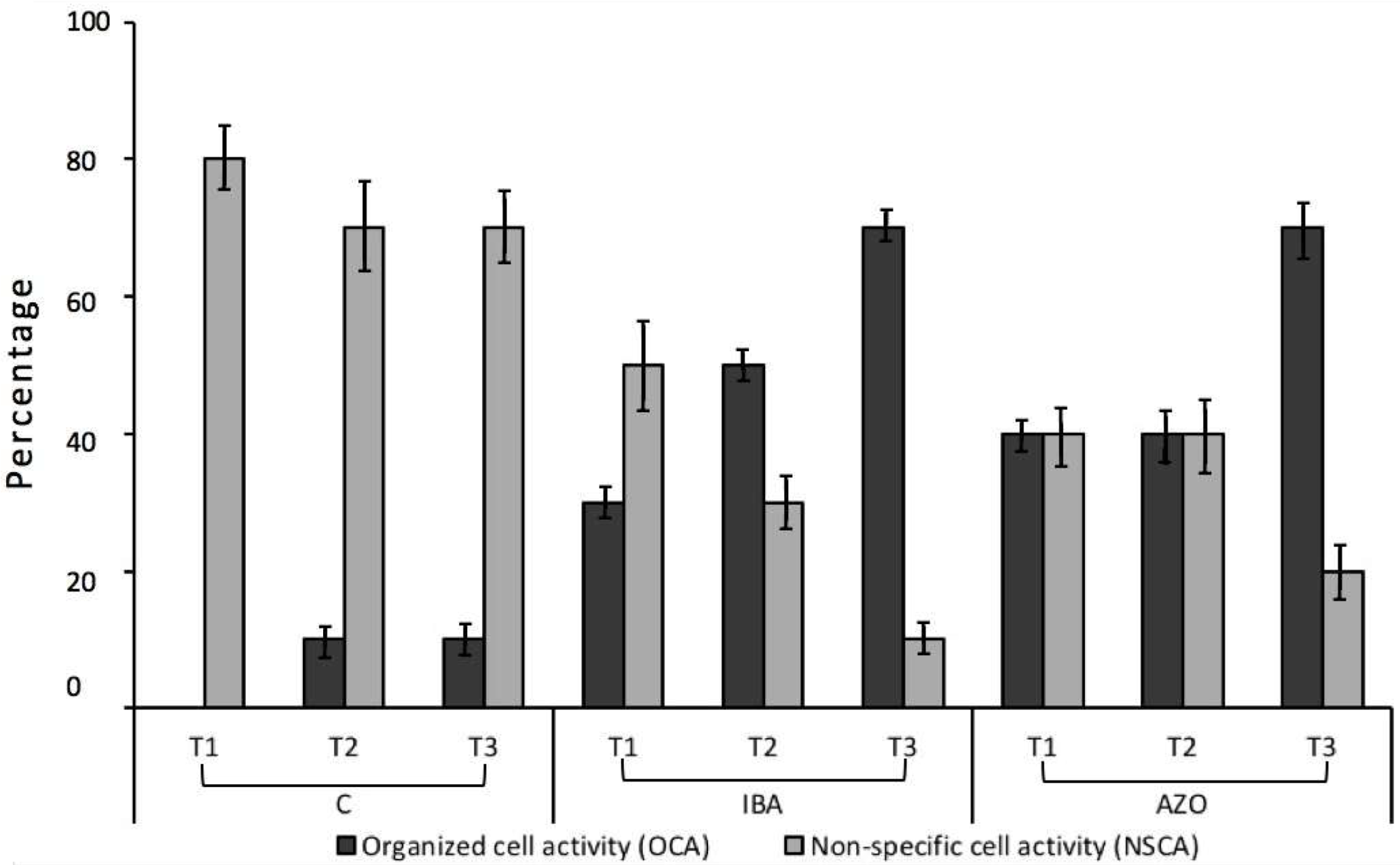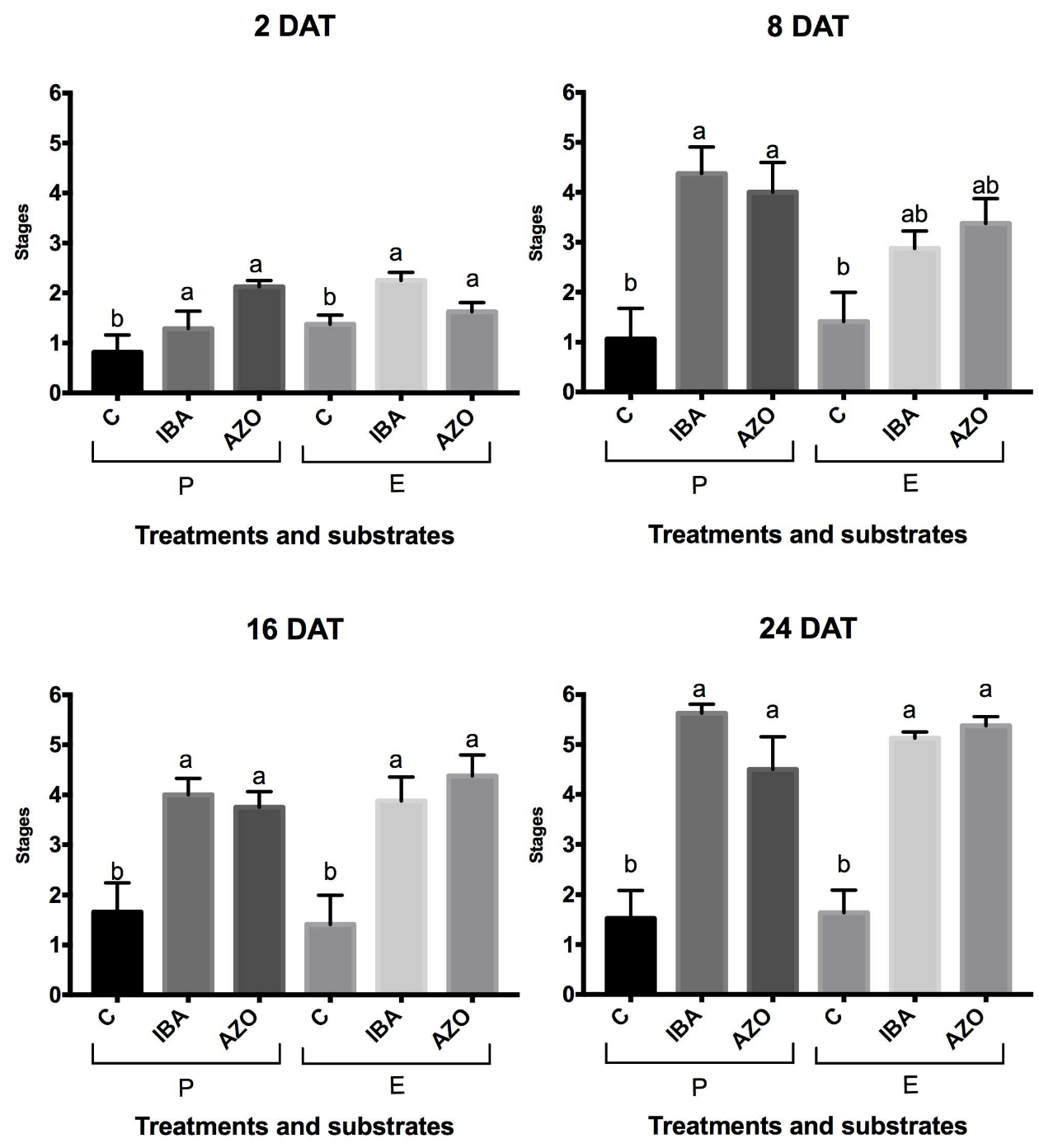Azospirillum baldaniorum Sp245 Induces Anatomical Changes in Cuttings of Olive (Olea europaea L., cultivar Leccino): Preliminary Results
Abstract
1. Introduction
2. Materials and Methods
2.1. Plant Material
2.2. Anatomical Observations
2.3. Evaluations on Cuttings
2.4. Statistical Analyses
3. Results
4. Discussion
5. Conclusions
Author Contributions
Funding
Data Availability Statement
Acknowledgments
Conflicts of Interest
References
- Hartmann, H.T.; Kester, D.E.; Davies, F.T.; Geneve, R.L. Plant Propagation: Principles and Practices, 6th ed.; Prentice-Hall Inc: Hoboken, NJ, USA, 1997. [Google Scholar]
- Fabbri, A.G.; Bartolini, G.; Lambardi, M.; Kailis, S. Olive Propagation Manual; Landlinks Press: Melbourne, VIC, Australia, 2004. [Google Scholar]
- Centeno, A.; Gomez-del-Campo, M. Effect of root-promoting products in the propagation of organic olive (Olea europaea L. cv. Cornicabra) nursery plants. HortScience 2008, 43, 2066–2069. [Google Scholar] [CrossRef]
- Stevens, C.V. The Chemical Biology of Plant Biostimulants; John Wiley & Sons: Hoboken, NJ, USA, 2020. [Google Scholar]
- Pii, Y.; Mimmo, T.; Tomasi, N.; Terzano, R.; Cesco, S.; Crecchio, C. Microbial interactions in the rhizosphere: Beneficial influences of plant growth-promoting rhizobacteria on nutrient acquisition process. A review. Biol. Fertil. Soils 2015, 51, 403–415. [Google Scholar] [CrossRef]
- dos Santos Ferreira, N.; Sant’Anna, F.H.; Reis, V.M.; Ambrosini, A.; Volpiano, C.G.; Rothballer, M.; Zilli, J.E. Genome-based reclassification of Azospirillum brasilense Sp245 as the type strain of Azospirillum baldaniorum sp. nov. Int. J. Syst. Evol. Microbiol. 2020, 70, 6203–6212. [Google Scholar] [CrossRef] [PubMed]
- Mancuso, S. Seasonal dynamics of electrical impedance parameters in shoots and leaves related to rooting ability of olive (Olea europea) cuttings. Tree Physiol. 1999, 19, 95–101. [Google Scholar] [CrossRef] [PubMed]
- Fukami, J.; Ollero, F.J.; de la Osa, C.; Valderrama-Fernandez, R.; Nogueira, M.A.; Megías, M.; Hungria, M. Antioxidant activity and induction of mechanisms of resistance to stresses related to the inoculation with Azospirillum brasilense. Arch. Microbiol. 2018, 200, 1191–1203. [Google Scholar] [CrossRef] [PubMed]
- Bashan, Y.; De-Bashan, L.E. How the plant growth-promoting bacterium Azospirillum promotes plant growth—A critical assessment. Adv. Agron. 2010, 108, 77–136. [Google Scholar]
- Cohen, A.C.; Travaglia, C.N.; Bottini, R.; Piccoli, P.N. Participation of abscisic acid and gibberellins produced by endophytic Azospirillum in the alleviation of drought effects in maize. Botany 2009, 87, 455–462. [Google Scholar] [CrossRef]
- Bartolini, S.; Carrozza, G.P.; Scalabrelli, G.; Toffanin, A. Effectiveness of Azospirillum brasilense Sp245 on young plants of Vitis vinifera L. Open Life Sci. 2017, 12, 365–372. [Google Scholar] [CrossRef]
- Toffanin, A.; D’ Onofrio, C.; Carrozza, G.P.; Scalabrelli, G. Use of beneficial bacteria Azospirillum brasilense Sp245 on grapevine rootstocks grafted with ‘Sangiovese’. In I International Symposium on Grapevine Roots; International Society for Horticultural Science: Leuven, Belgium, 2014; Volume 1136, pp. 177–184. [Google Scholar]
- Bartolini, S.; Pappalettere, L.; Toffanin, A. Assessing the effect of Azospirillum baldaniorum Sp245 on rooting ability of olive cuttings (Olea europaea L., cultivar Santa Caterina). Agrochimica 2022, (in press).
- Porfírio, S.; da Silva, M.D.G.; Cabrita, M.J.; Azadi, P.; Peixe, A. Reviewing current knowledge on olive (Olea europaea L.) adventitious root formation. Sci. Hortic. 2016, 198, 207–226. [Google Scholar] [CrossRef]
- Macedo, E.; Vieira, C.; Carrizo, D.; Porfirio, S.; Hegewald, H.; Arnholdt-Schmitt, B.; Peixe, A. Adventitious root formation in olive (Olea europaea L.) microshoots: Anatomical evaluation and associated biochemical changes in peroxidase and polyphenol oxidase activities. J. Hortic. Sci. Biotechnol. 2013, 88, 53–59. [Google Scholar] [CrossRef]
- Girelli, C.R.; Del Coco, L.; Angilè, F.; Scortichini, M.; Fanizzi, F.P. Olive cultivars susceptible or tolerant to Xylella fastidiosa subsp. pauca exhibit mid-term different metabolomes upon natural infection or a curative treatment. Plants 2021, 10, 772. [Google Scholar] [CrossRef]
- Mariotti, L.; Scartazza, A.; Curadi, M.; Picciarelli, P.; Toffanin, A. Azospirillum baldaniorum sp245 induces physiological responses to alleviate the adverse effects of drought stress in purple basil. Plants 2021, 10, 1141. [Google Scholar] [CrossRef]
- Elepot-Radici Più Forti in Meno Tempo. Available online: https://www.elepot.it/ (accessed on 9 January 2023).
- Sakai, W.S. Simple method for differential staining of paraffin embedded plant material using toluidine blue O. Stain. Technol. 1973, 48, 247–249. [Google Scholar] [CrossRef]
- Altamura, M.M. Root histogenesis in herbaceous and woody explants cultured in vitro. A critical review. Agronomie 1996, 16, 589–602. [Google Scholar] [CrossRef]
- Denaxa, N.K.; Roussos, P.A.; Vemmos, S.N.; Fasseas, K. Assessing the effect of oxidative enzymes and stem anatomy on adventitious rooting of Olea europaea (L.) leafy cuttings. Span. J. Agric. Res. 2019, 17, e0803. [Google Scholar] [CrossRef]
- Salam, A.J.; Qrunfleh, M.M. Anatomical aspects of rooting ‘Nabali ’and ‘Raseei’olive semi-hardwood stem cuttings. JJAS 2006, 2, 16–28. [Google Scholar]
- Larraburu, E.E.; Llorente, B.E. Azospirillum brasilense enhances in vitro rhizogenesis of Handroanthus impetiginosus (pink lapacho) in different culture media. Ann. For. Sci. 2015, 72, 219–229. [Google Scholar] [CrossRef]
- George, E.F. , Hall, M.A., De Klerk, G.J. Plant Propagation by Tissue Culture: Volume 1. the Background; Springer Science & Business Media: Berlin, Germany, 2007; Volume 1. [Google Scholar]
- Preece, J.E. A century of progress with vegetative plant propagation. HortSci. 2003, 38, 1015–1025. [Google Scholar] [CrossRef]
- Rademacher, W. Plant Growth Regulators: Backgrounds and Uses in Plant Production. J Plant Growth Regul. 2015, 34, 845–872. [Google Scholar] [CrossRef]
- Geiss, G.; Gutierrez, L.; Bellini, C. Adventitious root formation: New insights and perspectives. Ann. Plant Rev. 2009, 37, 127–156. [Google Scholar]
- Legué, V.; Rigal, A.; Bhalerao, R.P. Adventitious root formation in tree species: Involvement of transcription factors. Physiol. Plant. 2014, 151, 192–198. [Google Scholar] [CrossRef] [PubMed]
- Gellini, R. Seasonal Variation in The Rooting of Olive Cuttings; CABI: Wallingford, UK, 1965. [Google Scholar]
- Dalla Rosa, D.; Villa, F.; da Silva, D.F.; Corbari, F. Rooting of semihardwood cuttings of olive: Indolbutyric acid, calcium and Azospirillum brasilense. Comun. Sci. 2018, 9, 34–40. [Google Scholar] [CrossRef]
- Molina, R.; Rivera, D.; Mora, V.; López, G.; Rosas, S.; Spaepen, S.; Cassán, F. Regulation of IAA biosynthesis in Azospirillum brasilense under environmental stress conditions. Curr. Microbiol. 2018, 75, 1408–1418. [Google Scholar] [CrossRef]
- Rivera, D.; Mora, V.; Lopez, G.; Rosas, S.; Spaepen, S.; Vanderleyden, J.; Cassan, F. New insights into indole-3-acetic acid metabolism in Azospirillum brasilense. J. Appl. Microbiol. 2018, 125, 1774–1785. [Google Scholar] [CrossRef]
- Glick, B.R.; Todorovic, B.; Czarny, J.; Cheng, Z.; Duan, J.; McConkey, B. Promotion of plant growth by bacterial ACC deaminase. Crit. Rev. Plant Sci. 2007, 26, 227–242. [Google Scholar] [CrossRef]
- Bashan, Y. Inoculants of plant growth-promoting bacteria for use in agriculture. Biotechnol. Adv. 1998, 16, 729–770. [Google Scholar] [CrossRef]
- Molina-Favero, C.; Creus, C.M.; Simontacchi, M.; Puntarulo, S.; Lamattina, L. Aerobic nitric oxide production by Azospirillum brasilense Sp245 and its influence on root architecture in tomato. MPMI 2008, 21, 1001–1009. [Google Scholar] [CrossRef]
- Mehri, H.; Mhanna, K.; Soltane, A. Root growth of Arbequina cuttings as influenced by organic and inorganic substrates under the conditions of Al-Jouf (KSA). J. Plant Physiol. 2013, 8, 74–83. [Google Scholar] [CrossRef]
- Villa, F.; Silva, D.F.; Dall’Oglio, P.; Potrich, C.; Menegusso, F.J. Performance of substrates in rooting capacity of olive tree cuttings. Rev. Cienc. Agrovet 2017, 16, 95–101. [Google Scholar] [CrossRef]
- Therios, I.N. Olives; CABI: Wallingford, UK, 2009; Volume 18. [Google Scholar]
- Peixe, A.; Serras, M.; Campos, C.; Zavattieri, M.A.; Dias, M.A.S. Adventitious rooting in olive (Olea europaea L.) cuttings: A histological evaluation. Rev. Fac. Cienc. Agrar. 2007, 30, 476–482. [Google Scholar]





| 2 DAT | 8 DAT | 16 DAT | 24 DAT | |||||
|---|---|---|---|---|---|---|---|---|
| Main effect | F | p | F | p | F | p | F | p |
| Substrate | 0.75 | ns | 1.74 | ns | 0.57 | ns | 0.80 | ns |
| Treatment | 3.41 | 0.0426 | 13.87 | ≤0.0001 | 19.18 | ≤0.0001 | 25.65 | ≤0.0001 |
| S × T | 2.85 | ns | 1.50 | ns | 0.71 | ns | 1.25 | ns |
| Leafy Cuttings (%) | Calloused Cuttings (%) | |||||
|---|---|---|---|---|---|---|
| Substrate | IBA | AZO | C | IBA | AZO | C |
| Perlite | 95.3 ± 1.3 a | 90.0 ± 1.1 b | 82.8 ± 0.9 c | 18.2 ± 0.8 a | 11.3 ± 0.9 b | 1.2 ± 0.1 c |
| Elepot® | 89.8 ± 0.9 | 91.4 ± 0.9 | 90.5 ± 1.1 | 30.0 ± 1.1 b | 40.4 ± 1.1 a | 2.3 ± 0.6 c |
| t-test | ns | ns | ** | *** | *** | ns |
Disclaimer/Publisher’s Note: The statements, opinions and data contained in all publications are solely those of the individual author(s) and contributor(s) and not of MDPI and/or the editor(s). MDPI and/or the editor(s) disclaim responsibility for any injury to people or property resulting from any ideas, methods, instructions or products referred to in the content. |
© 2023 by the authors. Licensee MDPI, Basel, Switzerland. This article is an open access article distributed under the terms and conditions of the Creative Commons Attribution (CC BY) license (https://creativecommons.org/licenses/by/4.0/).
Share and Cite
Bartolini, S.; Pappalettere, L.; Toffanin, A. Azospirillum baldaniorum Sp245 Induces Anatomical Changes in Cuttings of Olive (Olea europaea L., cultivar Leccino): Preliminary Results. Agronomy 2023, 13, 301. https://doi.org/10.3390/agronomy13020301
Bartolini S, Pappalettere L, Toffanin A. Azospirillum baldaniorum Sp245 Induces Anatomical Changes in Cuttings of Olive (Olea europaea L., cultivar Leccino): Preliminary Results. Agronomy. 2023; 13(2):301. https://doi.org/10.3390/agronomy13020301
Chicago/Turabian StyleBartolini, Susanna, Livia Pappalettere, and Annita Toffanin. 2023. "Azospirillum baldaniorum Sp245 Induces Anatomical Changes in Cuttings of Olive (Olea europaea L., cultivar Leccino): Preliminary Results" Agronomy 13, no. 2: 301. https://doi.org/10.3390/agronomy13020301
APA StyleBartolini, S., Pappalettere, L., & Toffanin, A. (2023). Azospirillum baldaniorum Sp245 Induces Anatomical Changes in Cuttings of Olive (Olea europaea L., cultivar Leccino): Preliminary Results. Agronomy, 13(2), 301. https://doi.org/10.3390/agronomy13020301






